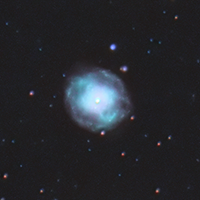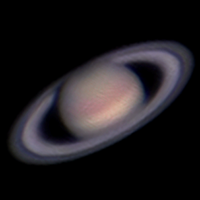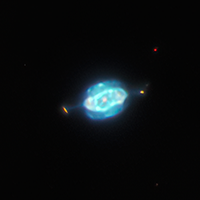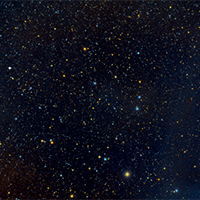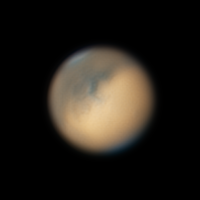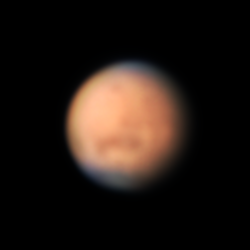Tagged: Planet
29-Sep-2022
When stars like the Sun are near end of life, they send their outer layers into space to create glowing clouds of gas, a planetary nebulae. This ejection of mass is uneven, and planetary nebulae can have complex shapes. This dying star is moving rapidly through space, resulting in a long tail of ionized hydrogen gas.
03-Jul-2022
Perhaps too small of an object for amateur equipment to tease out any details, I decided to try my luck on the Little Gem Nebula. NGC 6818 is roughly 6000 light-years away from Earth. The glow of the cloud is just over half a light-year across.
26-Nov-2020
The Red Spider Nebula (also catalogued as NGC 6537) is a planetary nebula located near the heart of the Milky Way.
23-Sep-2018
A glowing shell of ionized gas ejected from a dying star, IC5148 is at the end of its life, shedding its outer layers and contracting from a red giant to a white dwarf.
04-Jun-2018
Shapley 1 is a planetary nebula in the southern sky with a magnitude 14 white dwarf at it's center. It is approximately 4900 light years away, and one third of a light year across.
18-Apr-2018
NGC4361 is a planetary nebula with spiral arms similar to a galaxy. The star at the center of the nebula is shedding its outer layers while contracting to form a white dwarf.
28-Oct-2017
Uranus and two of its very dim larger moons, Titania and Oberon.
25-Oct-2017
Saturn and some of its many moons in infrared, red, green, and blue filters, taken with a new ZWO ASI 290MM high speed planetary camera.
11-Aug-2017
After a brief hiatus from astronomy to build a new, larger observatory, I've chosen another difficult target that was surprisingly bright.
19-Aug-2015
I thought I'd give eyepiece projection a try since my previous attempts at capturing Saturn were a dismal failure.
15-Feb-2021
Stars such as our Sun do not contain enough mass to finish their lives in the glorious explosions known as supernovae. However, they are still able to salute their imminent demise into dense, Earth-sized embers called white dwarfs by first expelling colourful shells of gas known as planetary nebulae.
27-Sep-2020
The Saturn Nebula is a tiny but complex planetary nebula, ~4000 light years away in Aquarius. The Saturn Nebula gets its name from its resemblance to the planet Saturn to the observer.
23-Jun-2019
Shown in this animation is the movement of Ceres over 8 hours, on the night of 4th June 2019, as it passed by the outer edge of IC4592, the Blue Horsehead Nebula.
14-Aug-2018
Mars is currently at it's closest to Earth since 2003, and appears as a brilliant red star in the sky. Unfortunately it is also suffering from a global dust storm, slowly abating.
11-Jul-2018
Mars is currently at it's closest to Earth since 2003, and appears as a brilliant red star in the sky. Unfortunately it is also suffering from a severe global dust storm, showing no signs of abating. This means even the polar ice caps are hard to see, let alone any surface features.
Page: 1, 2





